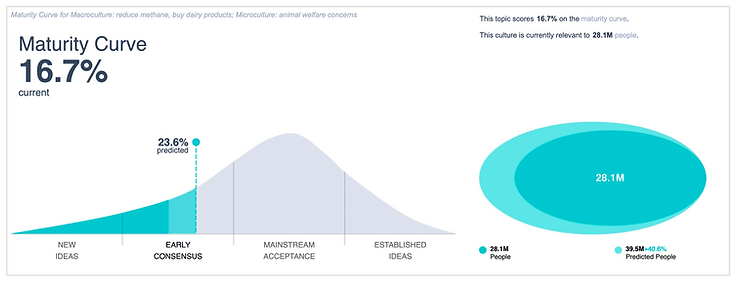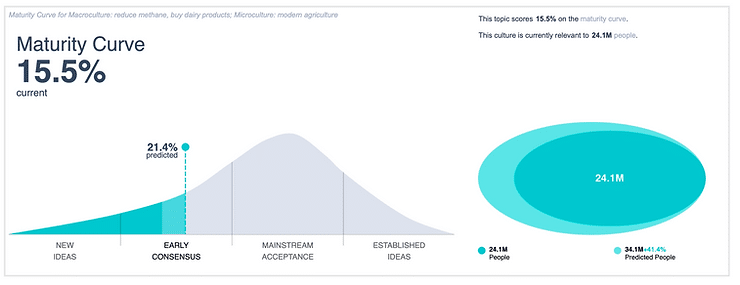How emerging concerns around methane will impact dairy consumption

Burps & farts. They are hilarious. But their impact on climate change is no laughing matter. Especially when it comes to the methane gas generated by livestock. As this article illustrates, belching bovines produce 26 percent of U.S. methane emissions related to human activities, second only to natural gas production (29 percent).
And, since more and more consumers are educating themselves on how their consumption is impacting others, we at MotivBase wanted to better understand how expectations around methane gas and dairy were shifting.
Namely:
- Who cares about this issue?
- What are the growing demands that consumers will increasingly place on brands and companies that require dairy production for their products?
To uncover the answers to these questions, we leveraged our MotivBase Trends Platform to perform an anthropological analysis of the meanings consumers link to Methane Reduction, in the context of buying dairy products.
Consumers want to advocate with their wallet
When we explore this culture of methane reduction, our system can analyze the language used by consumers as they directly and indirectly engage around a topic.
By applying structural anthropology to studying online data, we can not only identify new and emerging priorities for the consumer. But we can identify the unspoken motivations, attitudes, values and fears that are hidden in the language and word choice used by people as they discuss an issue.
Consumers who care about methane reduction believe in relying on scientific data and logic to make decisions on what is or isn’t good for them, their families, their communities, and the planet.
Not only do they value eco-centricity, but they are fearful that major corporations have too much power over a relatively compliant population that’s being kept in ignorance.
As a result they are motivated by a deep desire to prove they are trying to make the world a better place. This group is driven to make a difference through their actions. In their minds, this is more powerful than just words and helps to make the world slightly better than how they found it.
This movement is early on but growing.
When we examine how mature this mindset is in the marketplace, we can see that it is relevant to 34.8 Million Americans, and that it is still an “idea” that sits in Early Consensus.

From an anthropological perspective, a topic is mature when it is consistently understood to mean the same set of things in culture. And conversely, it is considered immature when the meanings that it stands for are constantly evolving or exhibit inconsistent patterns.
The further down the right a topic sits on the maturity curve, the more consistently it is understood by consumers to mean something(s) to them in their lives.
But while this movement is early on, our system predicts the population size will grow by +60% and the topic will reach mainstream acceptance in the next 12-24 months.
What is driving growth?
Within the Macroculture of Methane Reduction, our team of PhD Social Scientists was able to follow the breadcrumbs left by consumers to identify 4 key Microcultures that are driving increased awareness and concerns around this issue.
Consumers are Realizing Grass-fed = More Gas
Consumers are learning that dairy cows digest and absorb grains more easily than grass, producing less methane. This microculture is relevant to 36.3 million Americans and growing by 34%.

These consumers appreciate the environmental benefits of a quick-digesting diet that delivers more nutrients to cows and reduces their methane output at the same time. But they share concerns that growing grain for cattle may use up too much land.
Healthy Cows = Less Gas
Consumers believe that methane emissions can be reduced if dairy cows’ lifespan is maximized because so much methane is produced in the weaning and maturation years of replacement cows.
And they think that humane treatment of animals is the best way to achieve longevity. For example, they’re reading that regular rest from milking reduces exhaustion and helps prevent painful inflammatory conditions (e.g. mastitis) that lead to premature slaughter.
This microculture is relevant 28.1 million Americans and growing by +40%.

Burp Bibs to the Rescue.
Consumers are increasingly looking to the dairy industry to use the latest biotech to improve cows’ digestive chemistry and collect, convert, and recycle methane. This includes learning about solar-powered, wearable methane collectors that capture the methane that a cow exhales and turns it into CO2 and water. Or Burp Bibs that can be placed around a bovines face. Relevant to 24.1 million consumers, this desire for modernized solutions in agriculture is growing by +41%.

Consumers are “over” over production:
Overproduction in the dairy industry means overproduction of methane emissions. This microculture is relevant to 19 million Americans but is growing by +33%.

Consumer are increasingly getting frustrated by the food spoilage that comes from unsold dairy, and they think farms should scale back production to match consumer demand to eliminate food waste and reduce methane emissions.
Conclusion:
While the culture of reduced methane in dairy is still relatively small, we are seeing more and more consumers question the choices dairy producers make.
As more and more people grow increasingly aware of how their choices impact the environment, the more they will start to consider how their personal dairy consumption impacts the world around them.
Will consumers start to demonize grass-fed dairy, as they increasingly link this to promoting methane production?
Will consumers be willing to spend more for products where they feel confident the animals were treating humanely, not just for the good of the animal, but for the good of the planet?
Our findings would indicate the answer is yes.
But the rate of this change will depend on which companies embrace this consumer-led demand and make them more accessible to a larger, more mainstream group of consumers.
